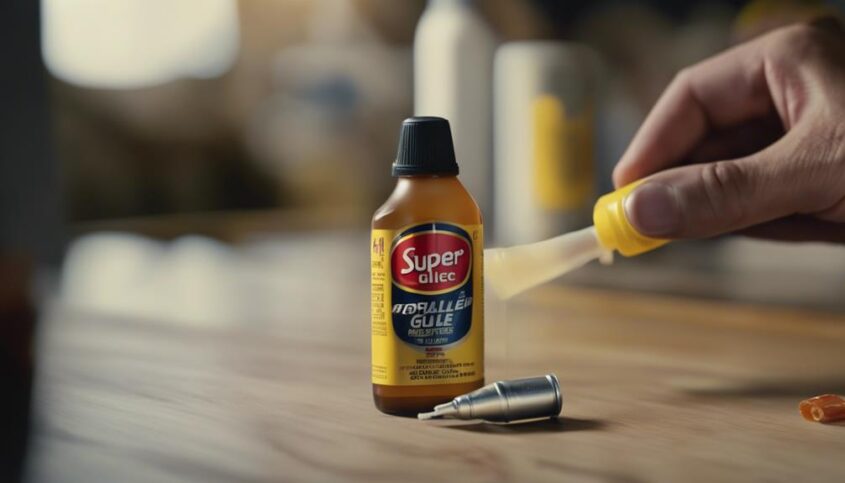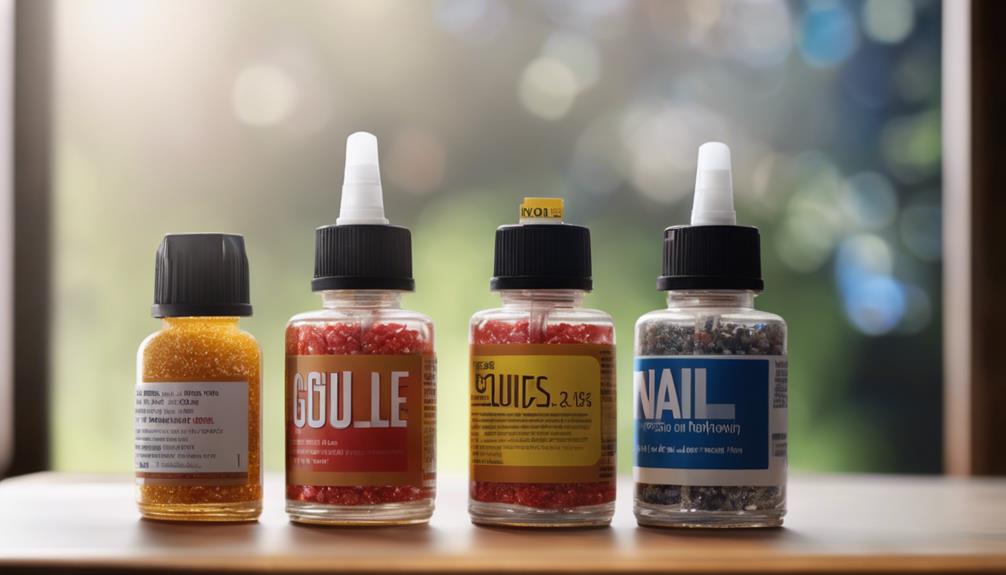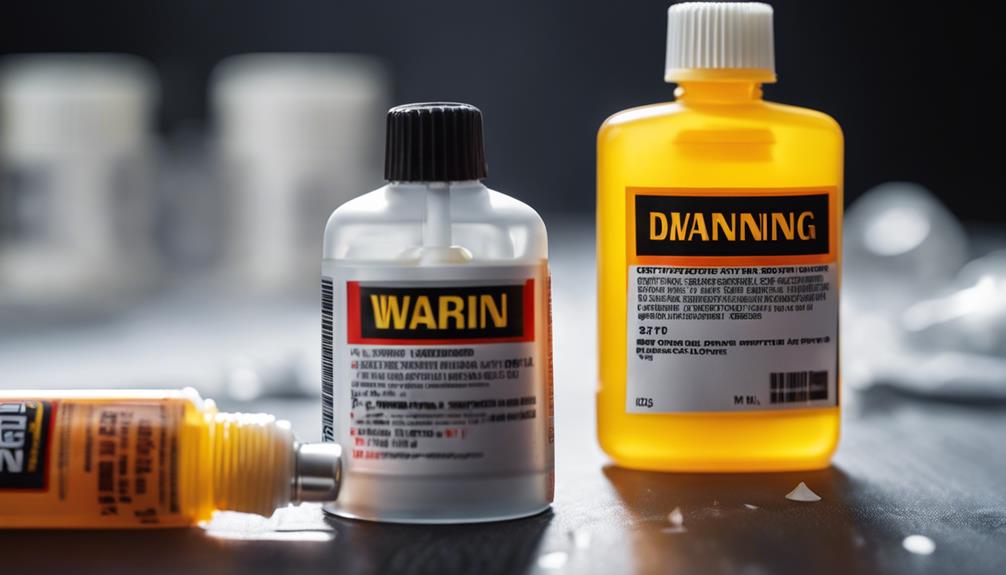Whats the Difference Between Nail Glue and Super Glue?

Nail glue contains ethyl cyanoacrylate for flexibility on artificial nails, while super glue uses ethyl or methyl cyanoacrylate for strong bonds on various materials. Nail glue provides adhesion and flexibility with acrylate copolymers, while super glue may have rubber for impact resistance. Super glue caters to diverse bonding needs with additives for temperature resistance. Nail glue dries fast for nails, but super glue cures even faster due to its composition. Understanding these distinctions helps ensure the right adhesive selection. See how each glue differs in application, strength, drying times, and safety for optimal usage.
Key Takeaways
- Nail glue contains ethyl cyanoacrylate for flexibility in nail enhancements.
- Super glue uses ethyl or methyl cyanoacrylate for strong bonds on various materials.
- Nail glue applied with brush-on applicator for precise artificial nail attachment.
- Super glue versatile for heavy-duty tasks like fixing metal, plastic, or glass.
- Nail glue removed with nail polish remover, super glue with acetone or debonder.
Composition Variances

Nail glue and super glue differ in their composition, with distinct variances in their chemical formulations. Nail glue, specifically designed for adhering artificial nails, typically contains ethyl cyanoacrylate as its primary ingredient. This compound is chosen for its flexibility and durability when bonding nail extensions to natural nails. On the other hand, super glue, also known as cyanoacrylate adhesive, is formulated with ethyl or methyl cyanoacrylate, offering a strong and fast bond for a variety of materials, including plastic, metal, and wood.
The difference in composition between nail glue and super glue lies in their additional components. Nail glue often includes ingredients like acrylate copolymers to enhance adhesion to the nail surface and improve flexibility to prevent breakage. Conversely, super glue may incorporate rubber for impact resistance or additives for temperature resistance to cater to its diverse bonding applications. These composition variances play a crucial role in determining the adhesive's suitability for specific uses and materials.
Application Distinctions
In terms of their practical usage, distinguishing characteristics emerge between nail glue and super glue, particularly in their application methods and target materials. Nail glue, specifically formulated for attaching artificial nails, typically comes in a brush-on applicator for precise and controlled application. On the other hand, super glue, known for its strong bonding capabilities, is applied using a nozzle or a tube for quick and easy dispensing.
| Application | Nail Glue | Super Glue |
|---|---|---|
| Method | Brush-on applicator | Nozzle or tube |
| Precision | Precise and controlled | Quick and easy |
| Target | Artificial nails | Various materials |
| Drying Time | Designed for nails | Quick bonding |
| Removal | Nail polish remover | Acetone or debonder |
These distinctions in application methods and target materials make nail glue ideal for nail enhancements, while super glue is versatile for various bonding needs across different materials.
Bonding Strength Comparison

When comparing the bonding strength of nail glue and super glue, it becomes evident that their adhesive capabilities vary significantly. Super glue, known for its exceptional strength, is designed for heavy-duty bonding tasks such as fixing metal, plastic, or glass. Its cyanoacrylate composition creates a powerful and durable bond that is difficult to break. On the other hand, nail glue is formulated specifically for attaching artificial nails to natural nails. While nail glue provides a strong bond for attaching artificial nails, its strength is tailored for this specific purpose and may not be as robust as super glue in other applications.
The bonding strength of these adhesives is tailored to suit the intended purpose. Super glue is preferred for projects requiring maximum strength and durability, whereas nail glue is optimized for nail-related applications. Understanding the specific bonding requirements of your project is crucial in selecting the right adhesive to ensure a secure and long-lasting bond.
Drying Time Differences
The speed at which each adhesive cures varies significantly between nail glue and super glue, impacting their respective drying times. Nail glue, formulated specifically for nail applications, is designed to dry relatively quickly to accommodate the needs of nail technicians and individuals seeking fast manicure solutions. This quick-drying characteristic of nail glue allows for efficient nail bonding without prolonged waiting times. In contrast, super glue, known for its versatility in bonding various materials, typically dries even faster than nail glue due to its cyanoacrylate composition. The rapid curing process of super glue is advantageous for quick fixes and immediate bonding requirements. However, this quick-drying nature can also pose challenges, requiring precision and swift application to ensure accurate bonding. Understanding the distinct drying times of nail glue and super glue is essential for choosing the most suitable adhesive based on the specific requirements of the intended application.
Safety Considerations

Ensuring proper ventilation and wearing protective gear are essential safety considerations when working with both nail glue and super glue. Adequate airflow helps dissipate fumes that may arise from the adhesives, preventing inhalation of potentially harmful chemicals. Protective gear such as gloves and safety goggles shield the skin and eyes from accidental contact with the strong bonding agents.
Moreover, it is crucial to store nail glue and super glue in a secure location, away from children and pets, to prevent accidental ingestion or misuse. In case of skin contact, immediate action should be taken to remove the adhesive using appropriate solvents recommended for the specific type of glue.
Additionally, both nail glue and super glue should be used in well-lit areas to avoid accidental spills or contact with the skin. Following these safety protocols ensures a safe and efficient experience when working with these powerful adhesives, allowing for creativity and innovation without compromising on well-being.
Frequently Asked Questions
Can Nail Glue Be Used as a Substitute for Super Glue in Everyday Household Repairs?
Nail glue can serve as a substitute for super glue in everyday household repairs due to its strong adhesive properties. However, it is essential to consider the specific materials being bonded and the strength required for the task.
Are There Any Specific Types of Nails or Materials That Should Not Be Used With Nail Glue or Super Glue?
In the realm of adhesion, discerning the suitability of materials is paramount. When using nail glue or super glue, exercise caution with porous surfaces such as untreated wood or certain plastics, as they may not bond effectively.
Can Nail Glue or Super Glue Cause Damage to Natural Nails or Skin if Not Used Properly?
Improper use of nail glue or super glue can lead to damage on natural nails and skin. It is crucial to follow instructions carefully to mitigate risks. Seek professional advice if unsure. Safety is paramount.
Is There a Recommended Shelf Life or Expiration Date for Nail Glue and Super Glue?
For optimal performance and safety, it is advisable to adhere to the recommended shelf life or expiration date for nail glue and super glue. This ensures product efficacy and minimizes the risk of potential damage or compromised results.
Are There Any Specific Tips or Tricks for Removing Nail Glue or Super Glue From Surfaces if Accidentally Spilled or Applied Incorrectly?
When dealing with spills of nail glue or super glue, acting promptly is key. Use acetone or nail polish remover for nail glue and isopropyl alcohol or citrus-based solvents for super glue. Gently pry apart surfaces to avoid damage.




